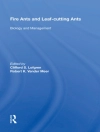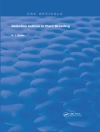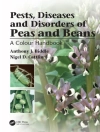This important book comprehensively reviews research on new developments in all areas of food chemistry/science and nutrition
Advances in Food Science and Nutrition covers topics such as food safety objectives, risk assessment, quality assurance and control, good manufacturing practices, food processing systems, design and control, and rapid methods of analysis and detection, as well as sensor technology, environmental control, and safety.
The thirteen chapters are written by prominent researchers from industry, academia, and government/private research laboratories around the world. The book details many of the recent technical research accomplishments in the areas of food science, including:
- Potato production, composition, and starch processing
- Milk and different types of milk products
- Processing and preservation of meat, poultry, and seafood
- Food ingredients including additives and natural plant-based ingredients
- Fruits and fruit processing
- Antioxidant activity of phytochemicals and their method of analysis
- The effect of food processing on bioactive compounds
- Food safety regulations including foodborne pathogens, probiotics, genetically modified foods, and bioavailability of nutrients
- Trends in sensory characterization of food products
- Ultrasound applications in food technology
- Transformations of food flavor including aroma compounds and chemical reactions that influence flavor
- Storage technologies for fresh fruits
สารบัญ
Preface xiii
List of Contributors xvii
1 Recent Advances in Food Science and Nutrition: State of Art, New Challenges and Opportunities 1
Visakh. P.M., Laura B. Iturriaga and Pablo Daniel Ribotta
1.1 Potato Production, Composition and Starch Processing 2
1.2 Milk and Different Types of Milk Products 4
1.3 Processing and Preservation of Meat, Poultry and Seafood 5
1.4 Food Ingredients 7
1.5 Fruits and Fruit Processing 7
1.6 Antioxidant Activity of Phytochemicals and Their Method of Analysis 9
1.7 Indispensable Tools in Food Science and Nutrition 10
1.8 Transformation of Food Flavours Due to Industrial Processing Elaboration 11
1.9 New Trends in Sensory Characterization of Food Products 12
1.10 Effect of Food Processing on Bioactive Compounds 13
1.11 Recent Advances in Storage Technologies for Fresh Fruits 14
1.12 Ultrasound Applications in Food Technology 16
References 17
2 Potato: Production, Composition and Starch Processing 23
Narpinder Singh, Amritpal Kaur, Khetan Shevkani and Rajarathnam Ezekiel
2.1 Introduction 24
2.2 Composition 24
2.3 Starch Production 34
2.4 Starch Properties 36
References 41
3 Milk and Different Types of Milk Products 49
Yantyati Widyastuti and Andi Febrisiantosa
3.1 Introduction 49
3.2 Milk Production and Quality 51
3.3.1 Effect of Animal Diet on Milk Productivity 51
3.2.2 Organic Milk 56
3.3 Types of Milk Products 56
3.3.1 Liquid Milk as Beverage 57
3.3.2 Cream 59
3.3.3 Butter 59
3.3.4 Ice Cream 60
3.3.5 Fermented Milk Product 62
3.4 Conclusion 65
References 65
4 Processing and Preservation of Meat, Poultry and Seafood 69
Elisabete M.C. Alexandre, Cristina L.M. Silva and Teresa R.S. Brandão
4.1 Introduction 70
4.2 Food Quality Characteristics 71
4.3 Deterioration and Microbial Contamination 73
4.4 Physical Methods of Preservation 74
4.4.1 Preliminary Processes 74
4.4.2 Water Spray-Washings 76
4.4.3 Control of Temperature 77
4.4.4 Control of Moisture 81
4.4.5 Radiation Technologies 82
4.4.6 Other Technologies 87
4.5 Chemical Methods of Preservation 89
4.5.1 Curing 89
4.5.2 Smoking 90
4.5.3 Other Methods/Compounds 91
4.6 Microbiological Contributions to Meat Preservation 93
4.6.1 Competition 93
4.6.2 Fermentation 94
4.6.3 Bacteriocins 94
4.7 Hurdle Combinations of Methods 95
4.8 Atmosphere Inside Package 95
Acknowledgments 96
References 96
5 Food Ingredients 105
Dongxiao Sun-Waterhouse
5.1 Introduction 106
5.2 Useful Terminology and Definitions 107
5.3 Food Additives 109
5.4 Novel and Natural Plant-Based Ingredients 113
5.5 Properties and Applications of Plant-Derived Ingredients 120
5.6 Conclusion and Future Prospects 125
References 126
6 Fruits and Fruit Processing 133
Ariel R. Fontana and Romina P. Monasterio
6.1 Introduction 133
6.2 Fruits 136
6.2.1 Low Temperature 136
6.2.2 Modified and Controlled Atmosphere Storage 137
6.2.3 Modified Atmosphere Packaging 140
6.2.4 Edible Coatings 141
6.3 Fruit Processing 142
6.3.1 Factors Affecting Fruit Conservation Method 143
6.3.2 Traditional Preservation Methods 144
6.3.3 Modern Preservation Methods with Minimal Processing 146
References 150
7 Antioxidant Activity of Phytochemicals and Their Method of Analysis 153
Ashish Rawson, Ankit Patras, B. Dave Oomah, Rocio Campos-Vega and Mohammad B. Hossain
7.1 Introduction 154
7.2 Importance of Antioxidants in Human Health (Their Mechanism of Action) 155
7.3 Natural Antioxidants 158
7.3.1 Sources of Natural Antioxidants 158
7.3.2 Uses of Natural Antioxidants 160
7.4 Overview of Methods Used to Measure Total Antioxidant Activity 163
7.4.1 Measurement of Antioxidant Activity 165
7.4.2 Assays Involving a Biological Substrate 165
7.4.3 Assays Involving a Non-Biological Substrate 166
7.5 Problems in Comparing Various Methods of Antioxidant Activity and Discrepancies over Their Measurement 188
7.6 Methods for Antioxidant Phytochemical Analysis 191
7.6.1 Spectrophotometer 191
7.6.2 High Performance Liquid Chromatography(HPLC) 191
7.6.3 Liquid Chromatography–Mass Spectrometry (LC–MS) 214
7.6.4 Liquid Chromatography–Nuclear Magnetic Resonance (LC–NMR) 215
7.7 Concluding Remarks 237
References 238
8 Indispensable Tools in Food Science and Nutrition 257
Sneha P. Bhatia
8.1 Introduction: Food Safety – From Farm to the Dinner Plate 257
8.2 Foodborne Pathogens 259
8.3 Probiotics in Food 264
8.4 Genetically Modified (GM) Foods – Friends or Foe? 270
8.5 Bioavailability of Nutrients 273
8.6 Food Safety Regulations 275
8.7 Conclusion 276
References 276
9 Transformations of Food Flavor Due to Industrially Processing of Elaboration 279
Romina P. Monasterio
9.1 Introduction 280
9.2 Aroma Compounds 292
9.3 Chemical Reactions that Contribute to Food Flavor 292
9.3.1 Maillard Reaction 293
9.3.2 Flavor from Lipids 298
9.3.3 Flavors Formed via Fermentation 302
9.4 Special Industrial Process and Flavor 309
9.5 Industrial Production of Flavor 312
9.6 Summary 315
References 315
10 New Trends in Sensory Characterization of Food Products 321
Gastón Ares and Ana Giménez
10.1 Introduction 321
10.1.1 Sensory Characterization 321
10.1.2 Descriptive Analysis 322
10.2 New Trends in Sensory Characterization of Food Products 325
10.2.1 Overview 325
10.2.2 Methodologies Based on Specific Attributes 327
10.2.3 Methodologies that Provide a Verbal Description of the Products 332
10.2.4 Holistic Methodologies 338
10.2.5 Methods Based on the Comparison with References 345
10.2.6 Comparison of the Methodologies 348
10.3 Conclusions and Recommendations 352
References 354
1 1 Effect of Food Processing on Bioactive Compounds 361
Sarana Sommano
11.1 Bioactive Compounds 362
11.1.1 Reactive Oxygen Species (ROS) 362
11.1.2 Antioxidant Defenses Against ROS 363
11.1.3 Bioactive Compounds or Natural Antioxidants 364
11.1.4 Other Significant Bioactive Compounds 371
11.2 Processing of Foods Containing Bioactive Components 372
11.2.1 Effect of Postharvest Handling Methods and Shelf Life Determination 372
11.2.2 Effect of Processing 373
11.2.3 Effects of Storage 377
11.3 Methods for the Determination of Antioxidants 378
11.3.1 Measuring Antioxidants Activity 378
11.3.2 Radical–Scavenging Methods 378
11.3.3 Methods for Measuring the Oxidation of an Oil or Food Sample 380
11.3.4 Techniques Involving Bioactive Compound Determination 383
Reference
12 Recent Advances in Storage Technologies for Fresh Fruits 391
Sukhvinder P. Singh and Leon A. Terry
12.1 Introduction 392
12.2 1-Methylcyclopropene (1-MCP) Based Storage Technology 393
12.3 Palladium Based Ethylene Adsorbers 394
12.4 Ultra Low Oxygen (ULO) Storage Technology 397
12.5 Dynamic Controlled Atmosphere (DCA) Storage Technology 398
12.6 Microcontrolled Atmosphere (MCA) and Bulk Modified Atmosphere Packaging (MAP) Technologies 400
12.7 Nitric Oxide Based Technology 401
12.8 Biosensors 403
12.9 Conclusions 405
References 406
13 Ultrasound Applications in Food Technology: Equipment, Combined Processes and Effects on Safety and Quality Parameters 413
Rui M.S. Cruz, Igor Khmelinskii and Margarida C. Vieira
13.1 Introduction 414
13.2 Equipment Design 416
13.3 Ultrasound Application for Improving Processing Efficiency 420
13.4 Food Preservation Applications 424
13.4.1 Enzymes 424
13.4.2 Microorganisms 424
13.5 Ultrasound Effects on Food Quality Attributes 430
13.6 Conclusions 432
References 432
Index 445
เกี่ยวกับผู้แต่ง
Visakh P.M. is a Senior Researcher at the School of Chemical Sciences, Mahatma Gandhi University, India. He has been invited as a visiting student/researcher to approximately fifteen European universities and is a prolific editor with seven books already published. His research interests include polymer nanocomposites, bio-nanocomposites, and rubber-based nanocomposites, fire-retardant polymers, and liquid crystalline polymers as well as silicon sensors.
Laura B. Iturriaga is a food engineer, researcher, and lecturer in the food physics and chemistry field at the Faculty of Agriculture and Industrial Agriculture, Universidad Nacional de Santiago del Estero, Argentina. She successfully defended her Ph D at the Universidad Nacional de La Plata (UNLP), Argentina.
Pablo Daniel Ribotta studied chemical engineering at the Facultad de Ciencias Exactas, Fisicas y Naturales, Universidad Nacional de Cordoba (UNC), Argentina, and completed his Ph D at the Facultad de Ciencias Exactas, Universidad Nacional de la Plata, in 2002. Currently, he is Research Member of the National Research Council of Republica Argentina (CONICET), as well as full professor of food technology and Director of Instituto Superior de Investigacion, Desarrollo y Servicios en Alimentos, at UNC. He has approximately seventy research papers, three books, and eight book chapters to his credit.












